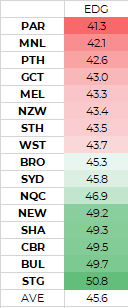 by ynot Wed Jul 21, 2021 7:17 pm
by ynot Wed Jul 21, 2021 7:17 pm
easytiger wrote:
Love your work ynot - it's always very interesting and you have to be a shoo-in for new poster of the year!
I did have a few thoughts on this - please forgive my musings (and they're certainly not in any way intended as a critique).
If there's any relationship it looks clear that it's with the more attacking positions - Halfback, Fullback, Wings, Centres etc
That leads me to suspect that margin of victory is maybe not as important as simply the points (or in fact tries) scored by a team.
If for instance Melbourne win two games; one by 40 - 0, the other by 60 - 20, I'd think on average the games that they score 60 points in would typically result in a highly level of Fantasy points (despite the same margin).
It also lends to the likelihood that the backs are most positively affected by scoring points (positions 1-7 have scored 76% of the tries attributed to starting 13 players this year and about 81% of TA's), then add in that they'd also dominate the associated LB's, TB's and LBA's directly related to those tries plus typically GK's too - and it's probably a fairly direct relationship between a team scoring more match points in a game leading to more fantasy points for those try scoring positions.
In terms of the query someone raised about whether it indicates correlation or causation, I think it's arguable that it's both.
Attacking players scoring fantasy points for attacking plays is a direct result of them scoring those points - those attacking plays generate fantasy points that lead to actual points (and add to margin or total points scored). They are literally interlinked.
I wonder if there would be a similar but slightly stronger relationship between total team points (or even more-so team tries) and fantasy point averages with backline roles - it seems to make sense on an intuitive level.
I guess the big problem is that even if you can predict more attacking points to a particular team (match-ups), it's much more complex to predict statistically how those points will be distributed in a way that indicates a certain player is more of a value pick over a certain other backline player - e.g. Wing A is going to dominate 50% more than their price point over the next 6 weeks (in a team expected to score points), whereas Wing B is only going to average around their price point generated across the rest of the season.
Probably the most obvious way is with a highly variable scorer that is down on value due to a run of tough oppostion, but heading into a much more favourable draw, while playing for a team that is likely to take advantage of that favourable draw (a good flat track bully team like Souths springs to mind).
I wonder if at present the best predictors of good value opportunities are fans that follow most matches and have a good understanding of a certain teams attacking structures vs upcoming match-ups defensive structures/weaknesses
Hey mate, this is awesome - fantastic points.
Totally agree re: total points scored, I think that's probably more correlated than margin. Let me take a look tomorrow.
The best way to understand how good a team is in a season is to look at their point differential - that will closer be to a teams true performance than their wins / losses. This is why I was looking at margin game to game.
But from a fantasy perspective I'm guess losing 50 - 30 is very different to 20 - 0 in terms of fantasy point output for the losing team, so margin probably doesn't matter so much.
I think you are right about positional matchups too, much more interesting to figure out Winger A vs Winger B than just distribute a predicted amount of tries across the back line. It would be cool to look at the matchups on the different edges, because ultimately they don't effect each other much.
This has kind of exploded my brain a little bit, need a dataset that labels players as left and right edge and then we could look at some good findings. I believe I could figure this out from some data I have floating around.
Might be time to build some machine learning models and get predictive.



